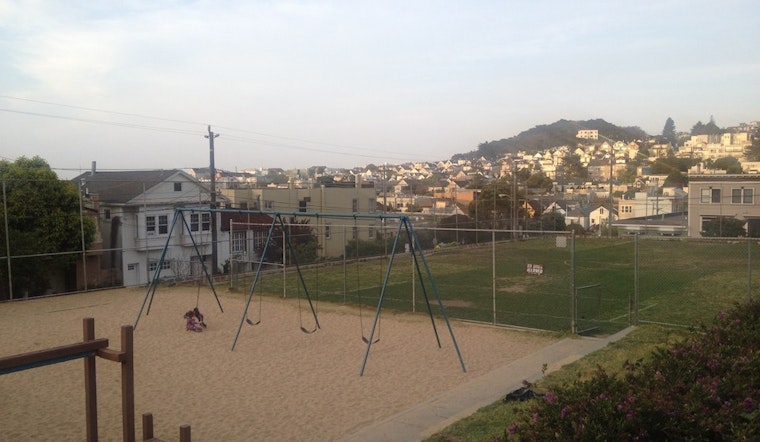
Last night, a Cole Valley neighborhood group called Friends of Grattan Playground met to discuss plans and priorities for renovating Grattan Playground, which was built at Shrader and Alma in 1974. The Department of Recreation and Parks maintains the space with help from volunteers who’ve been working to promote a major redesign.
In November 2014, the group’s grant application seeking makeover money from the City’s Community Opportunity Fund (COF) was turned down, despite the fact that Grattan Playground was rated “D” by the Failing Playgrounds Taskforce, an initiative funded by a 2012 bond issue. The group is seeking approximately $1.4 million for landscaping, improved drainage, ADA upgrades, new play equipment and other improvements.

“We want to get our community involved to figure out what our next steps should be,” said organizer Kitty Tierling. “The Community Opportunity Fund pot of money is only $1.2 million dollars, and they had 16 applications. Our application last year was for $500,000, less than half of the total amount of our full project.” The COF funds were distributed to projects that required “less money and showed more immediate success,” she said.
Rec and Park describes the COF as a “a six million dollar capital program that encourages residents, neighborhood groups, and park advocates” to compete for grants, private gifts, matching funds and volunteer time. The program’s goal is to improve parks by leveraging existing resources and contributions and promoting community engagement. Past COF-funded projects include Pioneer Park in North Beach and the Geneva Community Garden Project.
Friends of Grattan Playground wants to preserve sand as an essential element in the redesign, but the material is being phased out of the city’s playgrounds due to high maintenance costs. As playgrounds are improved and upgraded, Rec and Park is replacing sand with rubberized play surfaces and decomposed granite. The new policy notwithstanding, Rec and Park donated several tons of sand to Friends of Grattan Playground in April; volunteers spent several hours carrying loads in wheelbarrows and grading the new sand.

Grattan Playground received a “D” rating from the Failing Playgrounds Taskforce, but last night, organizers considered plans to reapply if funds become available in the future. Currently, the group is at an impasse, as their options are to resubmit the current design, revise the design as a nature or adventure pilot project, or continue to make small repairs and improvements, postponing major renovations. Even if they raise all of the project funds via donations, Rec and Park is still unlikely to approve a design that includes sand.
Alternately, the group can wait for Rec and Park to place a bond issue on the ballot, something that’s unlikely to occur until 2017 or 2018 at the earliest, said Steve Cismowski, a manager with the agency. Recently, a rusty merry-go-round was removed from the lower yard that’s slated to be replaced with a large tree trunk; several pieces of wooden play equipment show obvious signs of wear. “It really has not been touched since it was built, so it’s probably due,” said Cismowski.

Friends of Grattan Playground member William Hynes reviews the project proposal.
Friends of Grattan Playground has been working with San Francisco Parks Alliance to help keep the redesign on track and navigate the city’s approval process. Steve Schweigerdt, SFPA’s Director of Stewardship, said successfully funded projects “are kind of innovative,” like the new playgrounds at Mountain Lake Park and South Park.
“They’re doing some really interesting structures, and that’s exciting because the community is adding money on top of the bond money to make that happen,” he said. For proposals like the one for Grattan Playground, approximately 20-25 percent of a project’s cost is covered by private donations, said Schweigerdt.
At the end of the meeting, attendees broke into small groups to consider their next steps, and Cismowski thanked the group for its efforts. “The work that you have done is tremendous in helping us understand what your needs are,” he said.









